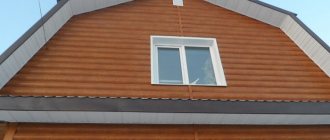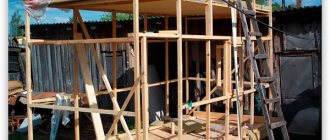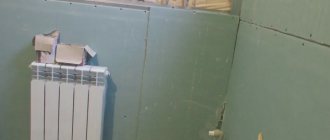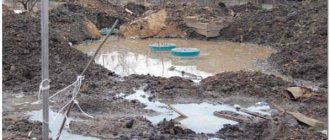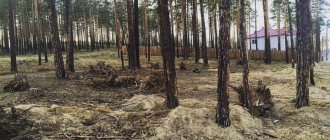When purchasing a plot of land for building a house, the question often arises about the unsuitable terrain and geology of the area for use, including for agricultural purposes.
This can occur in standing puddles after heavy rainfalls and during snowmelt. Also, soil can lose its load-bearing capacity when it becomes very loose. In any situation, excess liquid can have a negative impact on your home's foundation and landscaping. There is only one way out - to raise the site.
Filling the site is carried out in order to increase the filtration of the upper layers of soil or increase the level of the terrain.
Why is backfill needed?
The dream of any owner is a perfectly flat plot with a thick fertile layer of soil. Unfortunately, there are not so many immaculate plots of land. Most owners have to deal with various relief defects, and additionally with unfavorable geological conditions.
When simple leveling is not enough, it remains to decide how to raise the area in the country so that it becomes suitable for development. Territory reformatting may be necessary in the following cases:
- Low-lying location. When the plot is located below the surrounding areas, water will collect on it during rains or melting snow. Such regular flooding brings a lot of trouble and requires correction.
When any rain becomes a problem Source stroyfora.ru
- Wetland area. The cause may be groundwater passing close to the surface, or a nearby swamp. Damp, oversaturated soil is a big problem for a summer resident or owner of a country house; Backfilling will help make it drier.
- After some serious leveling. Potholes and uneven areas reduce the usable area and need to be removed. The grader removes a significant part of the fertile layer, so backfilling will be required for further use.
- Big slope. An area with a significant difference in elevation is unlikely to be completely leveled. Here, a more practical option would be to organize terraces with the construction of a retaining wall.
- Poor quality soil. If the earth is mixed with broken bricks, glass and other construction debris, and filled with fuels and lubricants, there is nothing left to do but raise the area.
After leveling, backfilling will be required Source beautiful-plot.rf
PROCEDURE
- Study the topography (soil type and presence of groundwater).
- Find out in which direction the water flows or stagnates.
- Clear the entire area of weeds, debris and tree roots, if any.
- Allow the soil to dry without rain for about a week.
As you can see, all of these activities are quite large and complex to carry out on your own. always ready to help you with this. The cost of filling a site with us directly depends on its area and the chosen method of work. Our company has everything to do this efficiently, quickly and at a professional level.
How to level and raise a site
The features of the relief determine both the methods of preparing the territory and the choice of materials. The following land plots need changes:
- With a significant single elevation. When a hill protrudes above the rest of the territory, it is cut off to level the surface, and the soil is often redistributed around rather than removed. If you plan to grow vegetables or sow a lawn, you need to add a layer of black soil (ideally 30 cm thick).
- In the lowlands. Sometimes owners choose a half-hearted solution, for example, raising beds and creating a small pond in the lowland. When this is not enough, they try to raise and drain the land. They use soil to raise the area or perform terracing.
Delivery of soil to the site Source marc2000.ru
- With a slant. A slight slope (up to 3°) is leveled by adding imported material in the low part of the site to the level of the highest point. If the slope is significant, terracing can be used. Terraces will help to zone the territory, use all the space and create a unique design.
Leveling work is carried out using the following methods:
- Manual method. Used on small, relatively flat plots (up to 8 acres). The fertile layer of soil (if needed) is removed with shovels and stored, then problem areas are leveled and the soil is returned. It will take approximately two weeks for the soil to become sufficiently compacted and suitable for cultivation.
- Leveling with a tractor. It is used on large plots or if there are significant differences in elevation. A bulldozer helps get rid of hillocks, ditches or ravines. Then it’s the turn of a tractor with a vertical cultivator to crush the top layer of soil. The prepared soil is harrowed, leveled, and compacted if necessary.
Leveling complex terrain with a slope Source blogspot.com
See also: Catalog of companies that specialize in designing and performing landscape work of any complexity
Filling a country or country plot with soil is used when it is necessary to raise the site. It is performed in the following ways:
- With preservation of the “native” fertile layer. The top layer of soil is removed and the area is leveled using heavy equipment. The prepared site is backfilled using imported sand or leveling soil (a more budget-friendly option). The layers are compacted, then fertile soil is returned.
- With the delivery of fertile soil. The allotment area is leveled, imported leveling soil is distributed on top, and then fertile soil is brought in.
- Without preserving the fertile layer. The territory is leveled using machinery, covered with imported soil, and compacted. This option is suitable if the owners do not intend to take care of the garden.
Leveling the site using technology Source ytimg.com
Raise the area with clay. Is it better to raise the area with clay or leveling soil?
Is it better to raise the area with clay or leveling soil?
Hello! I also decided to raise the site, it is 0.7 meters below the road, and the edge is 1.5 meters, 15 acres, in a triangle. At first I thought I’d get by, it’s not a cheap pleasure, there was no water on the site, because it’s on a slope, but the soil was wet under the grass, but it looked good, the groundwater in this area is high, 0.5-1 meters, but There is a small forest along the lower edge of the site and a stream in the center where water flows. I drove the tractor to level it, but it immediately sank, barely got out, went half a meter away! The soil appears to be loam, the water doesn’t drain away and it doesn’t look like it will dry out soon, because the weather leaves much to be desired, but construction needs to be done. The pile foundation with grillage will be 2 meters high.
I concluded from the advice to lift it right away and not put it off, the equipment won’t fit
Some suggested filling it with quarry soil, others with clay. For now I have agreed on clay, because it will be very budget-friendly (more than 1000 m3), only for diesel fuel. Bring it in, compact it and start building, there is no time for it to settle down on its own.
The question is whether this will be the best option, or whether leveling soil is better, it is a little more expensive, but as they say on the Internet, it is almost a panacea - a mixture of loamy or sandy soil and foreign impurities, such as fragments of stones, bricks, boulders. It compacts well, allows water to pass through better, and when fertilized it can be planted with something, not like clay!
Do I understand correctly, the clay will be compacted and will not allow water to pass below, so you need to make the correct slope with tamping in layers, after which you will need 10 cm of sand on top for drainage and only then a fertile layer! According to calculations, there will be 150 m3 of sand alone, which costs a pretty penny; clay, as well as leveling soil, will only cost delivery.
Leveling soil is also with layer-by-layer compaction. But it turns out to be a preparatory layer for fertility, and it won’t be more convenient to work with than with clay and dirt! Planting trees will be more convenient, not like in clay! But the water will mostly go down and disappear there slowly, which is not very good!
Drainage or drainage of water from the road is planned along the perimeter of the site, to a depth of up to a meter! Is it necessary? There will be a fence with a strip foundation that will also close it off from outside water!
How is bedding carried out?
Sites are being transformed in different ways: different technologies are used, different work is carried out. It is not surprising that different materials are also used. When choosing suitable soil for raising a site, we are guided by the following considerations:
- Fertile top layer. If you are raising a plot of land where you plan to cultivate crops and landscaping, form a top layer of black soil 20-30 cm thick. A layer of sand or gravel is placed underneath.
- Pit soil. It is used when the area is raised by more than 30 cm; It is also suitable for leveling driveways.
Different types of soil Source squarespace-cdn.com
- Recycled building materials. If it is intended to raise the ground level by a meter, a combined backfill is used. The bottom layer is formed from broken bricks in combination with secondary crushed stone, with the addition of a sand-gravel mixture.
- Sand, gravel, crushed stone. Good drainage layer, suitable for raising low-lying areas, as well as for arranging places with increased load (driveway, parking lot).
Soil distribution across the site Source blogspot.com
Why you shouldn't use crushed stone
Filling the area with crushed stone, although it is done, is quite rare. This is due to the fact that this building material is relatively expensive. Its cost is approximately 3 times higher than sand and 5 times more expensive than construction waste. If we compare the cost with the prices of soil and black soil, then crushed stone will cost 2 times more than any of these materials. Despite the fact that there are certain advantages to using crushed stone, most country property owners prefer to use sand or soil.
Stages of work
Lifting a site of any size goes through the following stages:
- Preparation. Before raising an area with a high groundwater level, a geological study is carried out: soil features are identified, the topography of the plot and neighboring territories is clarified.
- Design. A project is created and approved, which takes into account all significant information: the location of buildings, roads, other objects, as well as the choice of technology and materials.
Removing the fertile layer Source pastatupamatustatyba.lt
- Planning. The territory is marked out in accordance with the project into fragments with a different set of works: drainage installation, filling of various layers.
- Clearing and excavation. If it is planned to use the “native” fertile layer, then the area is cleared, and the soil is removed and stored until the final stage of work.
- Drying. The drainage system is installed in low-lying areas with constantly moist soil, or if seasonal flooding is observed.
- Lifting and leveling. The territory is raised to the planned level, if necessary, zoning is carried out. The site is made with a slight slope for better water drainage. The direction of the bevel is chosen individually.
Filling the swamp and raising the area Source marc2000.ru
Construction of artificial reservoirs
If the size and geological features of the site allow, then one of the ways to drain the site can be considered the creation of an artificial pond. This can be done when the lowest and wettest place is located on the periphery of the site. And although this method is called drainage without drainage, surface drains here can be present in the form of ditches designed as decorative or “dry” streams.
Briefly about the main thing
If the terrain of the site is unsuitable for use, and the ground is waterlogged, raise and level the relief area. Depending on its area, the problem is solved manually or with the help of heavy equipment.
Defects can be corrected in different types of areas: in a lowland, on a slope, with a hill. For lifting, different soil dumping schemes and different materials are used, depending on the intended use. In some cases (significant difference in heights), the surface level is raised with simultaneous terracing.
Ratings 0
Solving the blur problem
In order to prevent erosion of the soil, the lawn is fenced with a concrete fence, the height of which is a limit of 3 to 4 cm. But the installation depth of this structure in the ground should not exceed 20 cm. If you have determined that groundwater lies at a depth ranging from 1 to 2 m, then care should be taken to have a drainage system. In addition, a layer of sand or earth is poured on the area where the lawn is planted.
Benefits of groundwater
Even wells and boreholes that are fed by groundwater can be a positive example. Washing, washing, watering, and even water for drinking and cooking can be taken from these sources. Naturally, you cannot simply take water from a five-meter well and immediately drink it without any purification; you must use a much greater depth of water intake, and also be sure to purify the liquid with filters and neutralize its negative components by boiling.
We will install drainage channels in the future garden
A whole network of drainage channels is needed, they should literally encircle the area, you can even throw bridges over these channels and move along them to the main place, which will gradually drain.
Before constructing drainage channels, you need to determine which way your site slopes. After determining, try to make sure that the channels are directed exactly towards the slope. After digging them, be sure to cover them all with thick plastic film; it will protect the channels from overgrowing. Ultimately, all the channels should converge in one place, forming something like a pond, which will serve as an evaporator of excess moisture. It will be possible to draw water from it for irrigation.
Important ! The depth of the channels you dig should be no less than the depth to which the soil usually freezes in your region; for example, in the center of Russia the soil can freeze up to one meter.
If it is not possible to build a drainage pond, then at least make a drainage well, also directing all the channels from the site into it. But in this case, you will have to use a pump, which from time to time will need to pump out water from the site, draining the well.
What can you do to dry it out?
Since this phenomenon is not uncommon, there are several proven options for artificially lowering the water level.
All of them are associated with a significant amount of excavation work, so it is more advisable to carry them out before laying the foundation for the house at the beginning of construction.
The following methods are distinguished:
- A reservoir or pond for storing excess moisture.
- Open drainage.
- Closed drainage system.
- Construction industrial dewatering using wellpoints.


